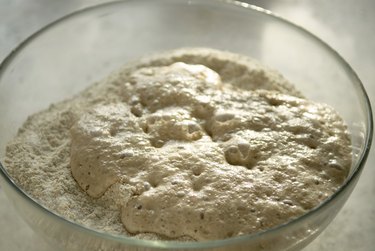
Whether you're a baking novice or a veteran, chances are you buy more dry active yeast than you're likely to use at one time. If you're not storing your leftover yeast carefully, you run the risk of losing some of your yeast's activity. Proper storage can extend the life of your yeast.
Storing Unopened Yeast
Video of the Day
An unopened package of active dry yeast has a long shelf life. Check the packaging for an expiration date; this can vary, but it's not uncommon for it to be two years from packaging. Even unopened yeast requires some precautions, though. Keep an unopened package of yeast in a pantry or cupboard; anywhere cool and dry is okay. If you like, you can even refrigerate or freeze unopened yeast, although you don't have to.
Video of the Day
Refrigerating Opened Yeast
Once a package of yeast is opened, it should be refrigerated or frozen. Before refrigerating yeast, minimize its contact with air as much as possible. Transfer it from its original package into an airtight container. Several smaller containers are better than one container that is too large for the yeast it holds. Refrigerated yeast should last for four to six months. When you need to use the yeast, remove the amount you need from the container and refrigerate the rest. Allow the yeast to return to room temperature before using it.
Freezing Yeast
Freezing yeast rather than refrigerating it makes the yeast last for at least six months without losing its activity. As with refrigerated yeast, pack frozen yeast in an airtight container with as little air as possible.
Testing Your Yeast
If you're uncertain whether your yeast is still active, you can check using a simple test recommended by Red Star Yeast. Dissolve a teaspoon of sugar in 1/2 cup of warm water, then stir in 2-1/4 teaspoons of yeast. Within a few minutes, the yeast should absorb the water and begin to rise. If the yeast doesn't rise, or if it only rises slightly, it may no longer be good. As a rule, this amount of yeast should expand to fill a volume of 1 cup.